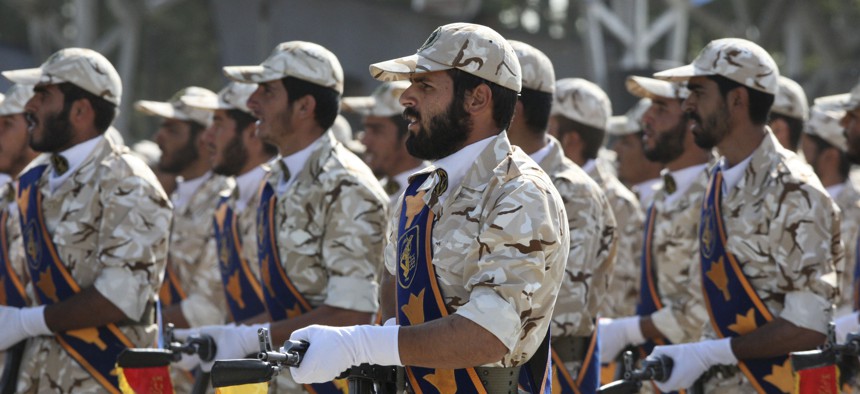
In this Sept. 22, 2011 photo, members of Iran's Revolutionary Guard march in front of the mausoleum of the late Iranian revolutionary founder Ayatollah Khomeini, just outside Tehran, Iran. Vahid Salemi/AP
It’s become a truism in American politics: Iran is “on the march.” Members of Congress can’t make it five minutes into hearings without reminding people. As news of the nuclear agreement broke this morning, Sen. Lindsey Graham told MSNBC’s Morning Joe, “I live in fear that we have set in motion a decade of chaos.” Why would the United States accept a deal with this Xerxes-esque menace?
The reality is that Iran is fighting to maintain a diminishing sphere of influence. And Washington mischaracterizes Iran’s actual position in the Middle East. Yes, Tehran covets a role as regional hegemon with power reaching beyond Shiite-controlled areas to become the hub of an anti-Israel axis that includes Sunni territories. But Iran is unable to move this strategy forward. What some of President Barack Obama’s critics portray as a newly aggressive Iranian policy instead reflects Iranian efforts to counter challenges it has not faced in decades. Facts on the ground simply do not support fears in Congress that a nuclear agreement will somehow empower an Iranian grab for regional hegemony. Obama’s nuclear deal should not be evaluated on the basis of hysterics about Iranian imperialism, but rather on its effectiveness at ending Iran’s nuclear ambitions.
Five years ago, Iran’s sphere of influence was secure. Its allies in Damascus and Beirut were comfortable and it was consolidating its control of Baghdad. Despite its Shiite identity, Iran sought to build a reputation as a sponsor of anti-Israel causes among Sunni groups, including Hamas. A 2010 poll found that the leaders of Iran’s “Axis of Resistance” were three of the top five most admired political figures in the Arab world. A majority of the Arab public also affirmed Iran’s right to a nuclear program, though they doubted its “peaceful” purposes as Iranian nuclear facilities expanded rapidly despite international sanctions.
In retrospect, that moment may represent the zenith of Iran’s power in the Middle East. Since then, Iran has been fighting a rearguard action at great political, financial and military cost to preserve the influence it took for granted just five years ago.
Syria is a dramatic example: Iran invests an estimated $6 billion annually and has sent tens of thousands of troops to prop up President Bashar al-Assad’s regime. Despite Iran’s support, the government controls a fraction of the country and is reviled internationally. The war has also stretched Iran’s Lebanese proxy thin: Hezbollah is believed to have deployed thousands of its fighters to Syria, straining its reserves of manpower. Casualties are eroding discipline and experts doubt Hezbollah could fend off Israel.
Tehran must also contend with new challenges to its influence in Iraq. Though many claim Iran’s support for Shiite militias in Iraq is a sign of its growing role, Iran has been active within that militant community since the U.S. invasion. Its role today is more overt and more costly, but not new. Today, Iran must spend resources to secure its unearned influence against ISIS.
With Iran’s focus on the Shiite crescent, it has done little to make new allies. Rumors of Iran’s support for Yemen’s Houthis have percolated since 2009, but aid was modest and kept at a level of plausible deniability. More recently, Iran’s efforts to manipulate the Houthis have proved disastrous. Iran advised the Houthi leadership against seizing Sana’a, but the group’s own ambitions and support from Yemen’s ousted president trumped Tehran’s influence. Iran is now stuck in a proxy war with Saudi Arabia that it had no intention of fighting.
Perhaps the greatest blow to Iran’s ambitions is the sectarianism of its own policies that has alienated the Arab public. In 2012, as the Syrian civil war grew more violent and sectarian, Hamas’ leadership broke publicly from Iran, decamping from its headquarters in Damascus. In return, Iran slashed support for the group and lost influence to Qatar and Turkey, who back Iran’s enemies in Syria. Though Iran reportedly still provides some aid to Hamas, it will be difficult to regain popular Arab support.
Iran certainly has long-term ambitions to expand its influence in the Middle East, and that aspiration challenges U.S. interests. However, the current narrative that Iran is newly ascendant in the Middle East is based on a superficial understanding of the region. In fact, Iran is struggling to maintain a grip, while its interventionist policies have weakened its allies and standing in the region.
If there’s one thing that the nuclear deal’s opponents are correct about, it’s that a nuclear weapon would make Iran’s foreign policy worse. By cutting all of Iran’s paths to a nuclear weapon and imposing an intrusive monitoring regime, the nuclear deal ensures that should Iran pursue its hegemonic dreams, it will do so without the benefit of a nuclear shield. For those truly concerned about Iran going “on the march,” a robust nuclear deal is something to be supported, not opposed.
NEXT STORY: A Good Iran Deal